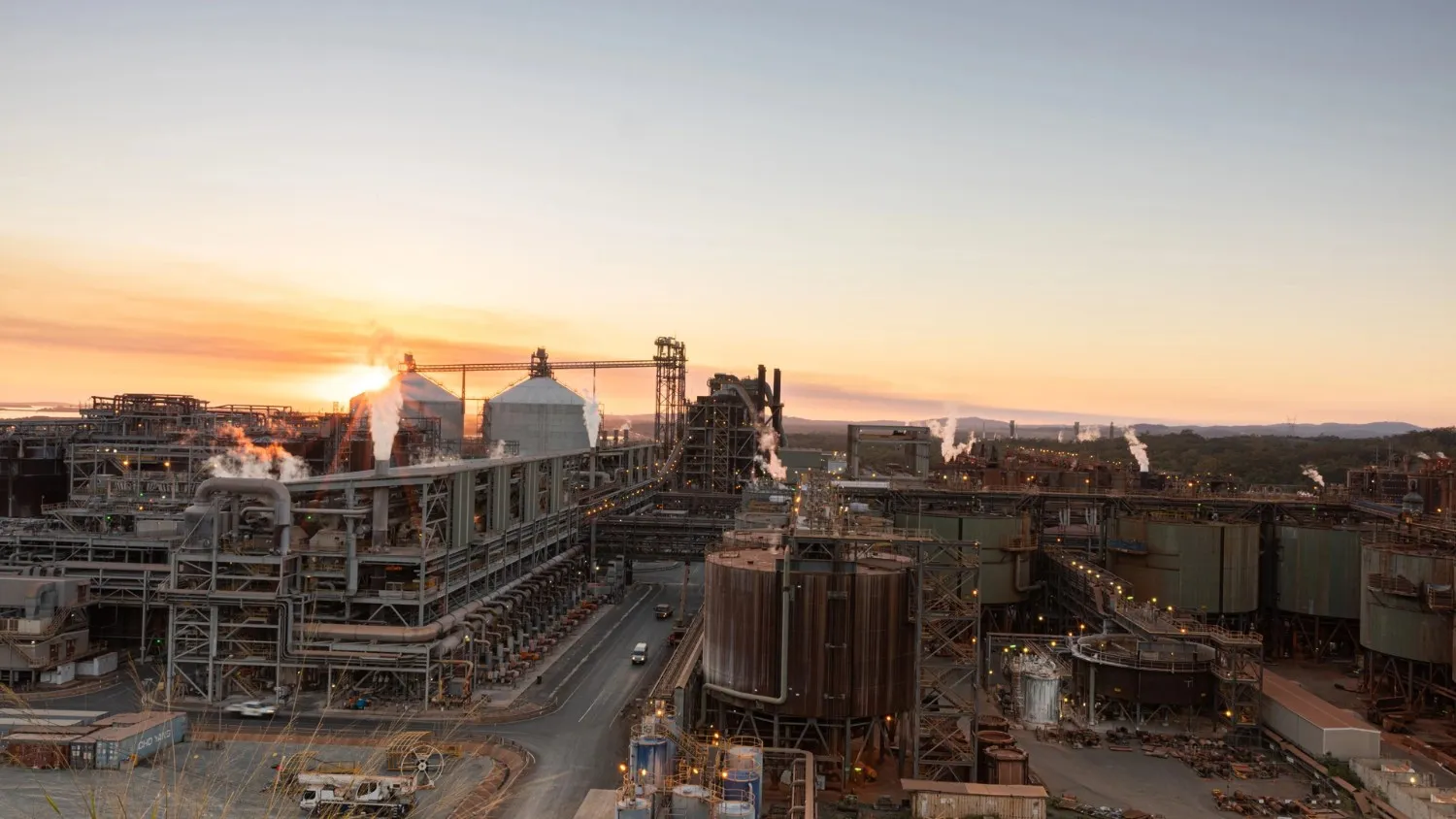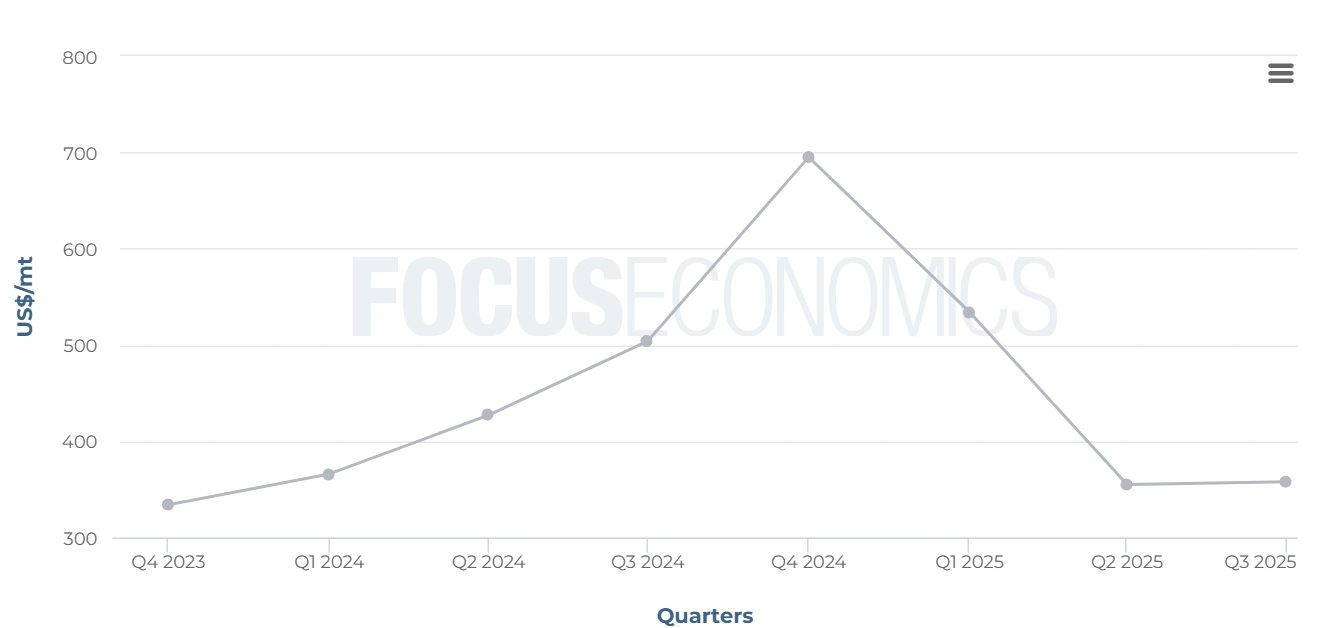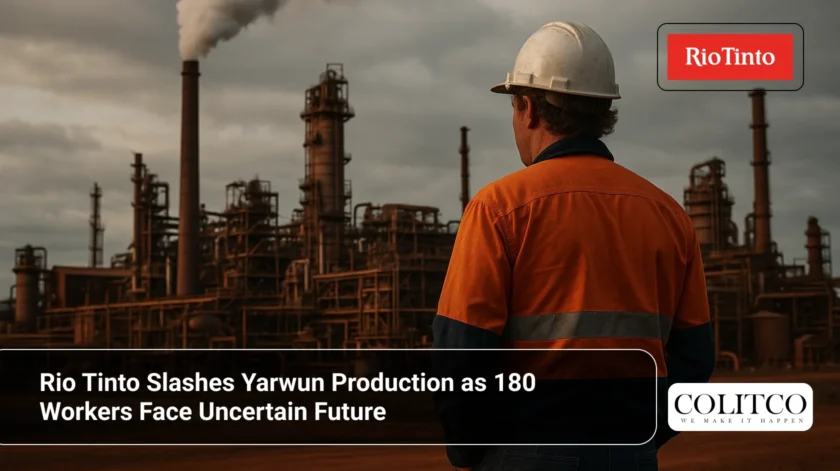Mining giant Rio Tinto has dropped a bombshell on Queensland’s industrial heartland. The company will slash production at its Gladstone Yarwun Alumina Refinery by 40% from October 2026. The decision puts 180 jobs on the line and marks a dramatic shift for one of the region’s cornerstone operations.
The production cut will reduce annual alumina output by roughly 1.2 million tonnes. Yarwun currently churns out approximately 3 million tonnes per year. The facility employs about 725 people and supplies feedstock to aluminium smelters across Asia.
Rio Tinto announced the decision on 18 November 2025. Company officials framed the move as necessary to extend the refinery’s operational life from 2031 to 2035.
Tailings Crisis Forces Rio’s Hand
The Gladstone Yarwun Alumina Refinery faces a looming infrastructure problem. Its tailings facility will hit maximum capacity by 2031 at current production rates. Red mud waste from alumina refining accumulates in these facilities, creating disposal challenges for the industry.
Rio Tinto explored building a second tailings facility over several years. The company ultimately deemed the investment “substantial and not currently economically viable.” Cutting production buys four additional years to explore technical solutions.

Gladstone Yarwun Alumina Refinery
Armando Torres, Rio Tinto Aluminium Pacific Operations Managing Director, addressed the difficult decision. He stated: “While we have extensively explored options to develop a second tailings facility for Yarwun over a number of years, the scale of investment required is substantial and not currently economically viable.”
Torres added: “Reducing production from October 2026 enables us to continue alumina production until 2035 and trial pathways to secure the longer-term future of Yarwun.”
Workers Face Redeployment Scramble
The production cutback affects approximately 180 roles at the Yarwun facility. Rio Tinto emphasised redeployment planning across its Gladstone sites as a “key priority.” The company operates multiple facilities in the region, including bauxite mines and aluminium smelters.
Those operations will continue at full capacity despite the Yarwun cuts. Rio Tinto stressed that customer requirements won’t be impacted. The company’s other alumina refineries will absorb the shortfall.
The announcement sends ripples through a community where mining jobs anchor the local economy. Gladstone’s industrial sector contributes approximately A$2 billion annually to the regional economy. Rio Tinto’s operations form a significant chunk of that contribution.
Workers and unions will scrutinise redeployment plans in coming months. The mining sector in regional Queensland already faces headwinds from fluctuating commodity prices and rising operational costs.
Alumina Market Feels the Squeeze
The Yarwun decision arrives as global alumina markets navigate choppy waters. Prices have swung dramatically in recent quarters due to supply disruptions and shifting demand patterns.
Australian alumina prices dropped sharply to US$355 per tonne FOB Brisbane in Q2 2025. That marked a 28.72% decline from the previous quarter. The steep fall reflected rebounding supply after major output curtailments in 2024.
Rio Tinto’s Gladstone operations previously weathered a gas pipeline explosion in April 2024. That incident disrupted production at both Yarwun and the Queensland Alumina Limited refinery. The facilities have since recovered to approximately 75% and 86% capacity respectively.
China’s alumina market also experienced significant volatility. Prices fell 24.79% quarter-on-quarter as oversupply from capacity expansions flooded the market. More than 13 million tonnes of new refining capacity came online in China. Large-scale projects in Indonesia and India added further pressure.
The global alumina market faces an oversupply situation heading into 2026. New capacity in Indonesia and China is expected to sharply reduce the 2024 deficit of 3.0 million tonnes. This oversupply environment makes costly infrastructure investments like new tailings facilities harder to justify.

Alumina Price Trends 2023-2025
Innovative Solutions on the Horizon
Rio Tinto isn’t abandoning Yarwun entirely. The company plans to trial innovative tailings solutions during the extended operational window. These include neutralisation techniques and centrifuge-based dry tailings processing.
The refinery will also pursue decarbonisation technologies. Rio Tinto aims to replace coal and gas in boilers with biofuels. The company is delivering the Hydrogen Calcination Project, a world-first initiative backed by Australian Renewable Energy Agency (ARENA) funding.
Torres emphasised Yarwun’s ongoing importance: “Yarwun remains an important operation for Rio Tinto and the company will continue to focus on innovative tailings solutions at the operation.”
The company is committed to its alumina and aluminium operations in Gladstone. Rio Tinto will work closely with employees, contractors and suppliers to manage the transition.
Regional Economic Implications
Gladstone’s economy heavily depends on heavy industry. The region hosts multiple alumina refineries, a major aluminium smelter, and significant port infrastructure. These facilities create thousands of direct and indirect jobs.
The Yarwun cutback adds to existing pressures on Queensland’s aluminium sector. South32’s Worsley refinery previously lowered its alumina production forecast for FY25 by approximately 250,000 tonnes. That decision stemmed from delays in environmental approvals and conveyor belt maintenance.
The global aluminium and alumina industries face structural challenges. Rising energy costs, environmental regulations, and competition from lower-cost producers in Asia squeeze margins. Australian refineries must justify premium operating costs with superior efficiency or strategic advantages.
Gladstone benefits from established transport infrastructure and proximity to Asian markets. However, the region’s refineries compete against new, modern facilities in Indonesia and India. Those operations often enjoy lower labour costs and newer technology.
What Happens Next
Rio Tinto will begin detailed planning for the production reduction over coming months. The company needs to maintain operations safely while managing workforce transitions. Redeployment opportunities across other Gladstone facilities will be assessed.
The extended timeline to 2035 provides breathing room for technical innovation. Rio Tinto’s research teams will test new approaches to tailings management and processing efficiency. Success could enable further life extensions beyond 2035.
The company faces a delicate balancing act. It must maintain profitability while investing in solutions for long-term sustainability. The outcome at Yarwun could influence similar decisions at other refineries worldwide.
Industry observers will watch whether Rio Tinto’s innovative solutions pan out. The hydrogen calcination project represents cutting-edge technology. If successful, it could provide a template for decarbonising alumina refining globally.
Market Response and Outlook
Rio Tinto shares (ASX: RIO) traded at $129.27 as of 18 November 2025. The stock sits within a 52-week range of $100.750 – $135.240. The company maintains a market capitalisation of approximately $49.21billion.

The Yarwun announcement represents one piece of Rio Tinto’s broader strategic pivot. The company is reducing reliance on iron ore while expanding into copper, lithium and critical minerals. Aluminium and alumina remain important but face mounting competitive pressures.
Investors will scrutinise how effectively Rio Tinto manages the workforce transition. The company’s reputation took a battering after the 2020 Juukan Gorge destruction. Handling the Yarwun restructure sensitively matters for stakeholder trust.
The broader alumina market faces continued uncertainty. Supply expansions in Asia will likely keep prices subdued through 2026. Australian refineries need exceptional efficiency or strategic positioning to remain competitive.
For Gladstone’s workers and community, the coming months bring anxiety and difficult choices. The region has weathered industry cycles before. This latest challenge tests resilience once again.












